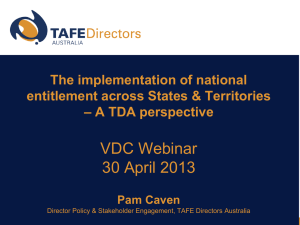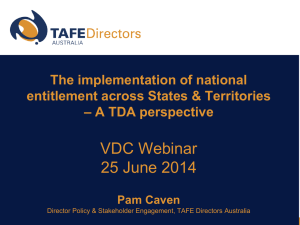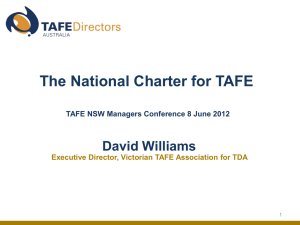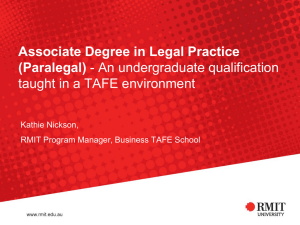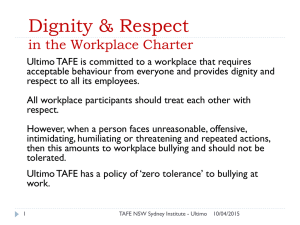Follow this link - Australian Education Union (SA Branch)
advertisement
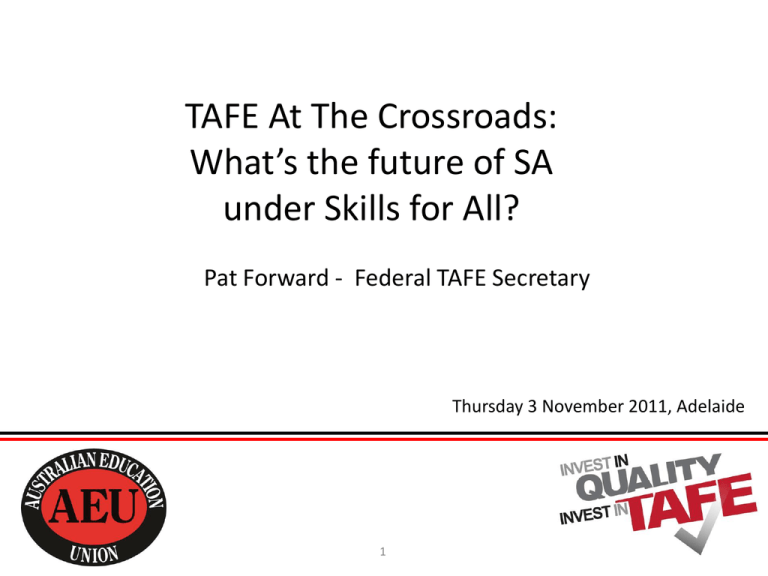
TAFE At The Crossroads: What’s the future of SA under Skills for All? Pat Forward - Federal TAFE Secretary Thursday 3 November 2011, Adelaide 1 What’s happening around Australia? 2 Victoria • Victorian Training Guarantee is fully implemented • The Victorian system is in crisis • Victoria is the lowest funded TAFE system in the country 3 South Australia • Implementing Skills for All • The second most marketised state in the country •Funding has declined, and the government wants to reduce it further 4 Queensland •Queensland Government has accepted all recommendations of the Noonan review •Proceeding down the same path as Victoria •Consulting around the implementation of its reform process 5 Western Australia •Announced that it would be making 50% of its government funding for VET contestable in 2009 •Currently determining reform agenda 6 New South Wales • NSW Government is implementing market reform of TAFE – has released discussion paper – and is holding a short round of consultations around its proposed reforms • Passed legislation to remove TAFE teachers from the state IR system by making them employees of the NSW TAFE Commission 7 Tasmania •Tasmania has split its public VET delivery between a Skills Institute and a Polytechnic •The aim of the Skills Institute is to move to full cost recovery •The government has announced a review of Tasmania Tomorrow 8 NT & ACT • All public VET delivery in NT through dual sector university, Charles Darwin • All public VET delivery in the ACT is currently through Canberra Institute of Technology • A review is underway to examine an amalgamation between CIT and the University of Canberra 9 What has happened in Victoria? •The Victorian Training Guarantee is a training entitlement - students are “entitled” to a government subsidised place with the level of funding and cost to the student dependent on the qualification level. •TAFEs in Victoria are autonomous – they are the employers of TAFE teachers and have been since the mid 90s. 10 Key Features • All government VET funding open to competition from public and for-profit private providers •Government partially subsidises qualifications at all levels, with the amount of government subsidy reducing and the amount of student fee increasing as the qualification gets higher •TAFE receives some additional funding from government because it is a “full service provider” – additional funding drops out at Diploma and Advanced Diploma levels •Students only receive government subsidy for qualifications above the highest qualification they hold – with some few exemptions •Students must pay full costs for training at the same level, or below •Student contact hour funding “weighted” depending on industry area •Income contingent loans available for Diplomas and Advanced Diplomas 11 VICTORIA What has happened in South Australia? •Skills for All to be implemented from mid 2012 •Skills for All will be based on a training entitlement, where students will be eligible for a government funded place with the level of funding and cost to the student dependent on the qualification level 12 Key Features SOUTH • All VET funding open to competition from public and private AUSTRALIA providers •TAFE SA as a separate government-owned statutory authority with each of the existing three institutes as a subsidiary; •Purchaser/provider split enacted from July 1 2011 through the formation of the Office of TAFE SA •Income contingent loan system in place by September 2012, with loan arrangements published and in place by the end of 2011, subject to agreement with the Commonwealth •No student fees at CI and II and below, with the government fully subsidising the cost •CII and IV will be 80% subsidised, and Diploma and Advanced Diploma 70% subsidised. •As in Victoria the ICL would be available for these higher level qualifications. The SA government has taken a different approach than Victoria to the capacity access public funding for qualifications at the same level or below, but with a range of restrictions. •Concessions will be available for students at C III and IV 13 Skills for All policy is being introduced in the context of an additional $194 million over the next six years, and a target of 100,00 additional training places. The Victorian government committed an additional $316 million over four years when it announced its Securing Jobs for Your Future, with a target of 172,000 additional training places When Victoria commenced its reforms, its funding per student contact hour was already the lowest in the country: $12.12 (2008) with the national average at $13.40. This dropped to $11.96 in 2009! 14 SA “reform” aims • South Australian reforms aim to reduce funding per student contact hour. Skills for All sets a target of a reduction of 10% by 2012 “to match other Australian jurisdictions”. • Since 2005 the VET cost per hour in SA has dropped 14.1% • The aim of Skills for All is to move the South Australian VET system closer to the national funding average, which will “require further efficiencies from TAFE SA” • Signals a number of areas where TAFE must change to make it “more responsive” to industry and student needs. 15 •SA Government says the establishment of TAFE as a statutory authority will give TAFE greater commercial autonomy, financial independence and autonomy. Skills for All articulates a number of critical and ongoing functions which may be required of TAFE… •But…no details about how these additional requirements are to be funded •Government says TAFE will receive (unspecified) additional funds for the purchase of specific services, CSOs and market transition risks through the implementation phase through purchasing agreement with the government. 16 Crisis in Victorian TAFE • TAFE market share dropped from 75% (2008) to 52% (2011) • Private provider share has grown from 15% to 32% • 16 out of 18 TAFE institutes now reporting significant deficits • VET budget has been Victoria overspent by $400 million • Unprecedented growth in a number of high volume, non skills shortage training areas • 3000% growth in the delivery of personal training qualifications • Decline in delivery of diplomas and advanced diplomas. 17 Victorian Essential Services Commission Review The Commission conducted a review and recommended: •Progressively removing the increased funding that TAFE institutes received over the next four years •Altering industry weightings to control the growth of training in some industry areas •Decreasing funding to university diplomas and advanced diplomas to act as a disincentive to universities picking up market share in these areas •Defining and specifying, and then separately purchasing community service obligations from all providers •Removing the caps and floors on fees 18 Victorian Government response to the crisis •Reduced the TAFE funding differential in the largest 8 metropolitan institutes by 25% •Removed the caps and floors on fees •Removed the differential funding arrangements for apprentices •Altered the weightings in some industry areas in an attempt to influence market behavior. 19 Changes to TAFE Funding Rates In Victoria 20 What does this mean? TAFEs in metropolitan areas are being punished by the government for the budget blowout - there has been massive growth in private provision, but the response targets TAFE, not private providers. The removal of caps and floors in fees will have two effects: • Providers will be able to charge whatever the market can bear for popular VET courses and shift costs directly onto students. • Private providers will now be able to charge students nothing for training – deliver training in a fraction of the time, and reap the government subsidy for minimal or no effort. 21 What are the lessons of the Victorian market reform? Victoria is the second largest and most commercially oriented TAFE system in Australia. It cannot compete on costs with private providers. It cannot survive market reform if it continues to offer high quality training . And: The Victorian government is still considering the Essential Services Commission Review – and all 45 recommendations are for further marketisation! 22 What governments are saying and what it really means: They want to give students an entitlement to training Students already have an “entitlement” to training at TAFE They want to make the system “demand driven” The TAFE system is and always has been “demand driven”! TAFE receives funding directly from government in response to demand from students and industry. TAFEs need to become more flexible and responsive TAFEs deliver training when and where it is required in every industry sector in the Australian economy. Calling for more flexibility is really a call to cut teachers’ wages and conditions 23 Low completions could be fixed by outcomes based funding Low completion rates are a serious problem, but the only response has been a call to use outcomes based funding. Little or no attention has been paid to the low funding rates, attack on students services and support and the cut backs on teachers time. Making students pay more for training, offering income contingent loans, and making funding fully competitive will fix the problems The VET sector is the worst funded education sector in the country. Reforms being proposed are not about increasing funding, but shifting funding from government to individuals through increasing student fees. Also, it is clear that there are significant concerns with quality in a system where the funding per student contact hour continues to decline 24 Nationally, funding per student per contact hour has declined annually for almost 16 years It has declined by -25.7% from 1997-2009 -17.7% from 1998-2009 -15.4% from 2005-2009 In SA, funding per student contact hour has declined for 16 years It has declined by -26.4% from 1997-2009 -3.0% from 1998-2009 -19.5% from 2005-2009 25 Rent-seekers, industry leadership and subsidies for business – the truth behind market reform “In economics, rent-seeking is an attempt to derive economic rent by manipulating the social or political environment in which economic activities occur” The Commonwealth government spends almost a billion dollars a year on subsidies or incentives to industry through apprenticeships and traineeships. State governments have their own industry welfare schemes. Governments applaud the fact that the Australian VET system is “industry led”. They fund employer subsidies through traineeships and apprenticeships, they fund industry skills councils which determine the Training Packages and qualifications which underpin, and drive the system. They give industry a voice through representation on boards and government committees. There is an argument that industry does a lot of its own training, without calling on government funding to deliver, but there is no accurate account of how much non-government funding goes into VET. Industry bodies provide government with advice about VET policy, and then they set up their own RTOs to bid for government funding and to deliver training. This is rent seeking behavior. 26 What one Victorian TAFE said about the Victorian reforms in their submission to The Essential Services Review … ... (the Victorian Training Guarantee is) a thinly disguised initiative to increase statistical VET participation, regardless of training quality and integrity, and regardless of the training requirements of industry and the needs of individuals. Northern Metropolitan Institute of TAFE believed from the outset that this was an attempt to largely privatise the VET system by stealth, based on unproven and spurious assumptions. 27 Collapse in Diplomas and above in Victoria 2009-2010 Percentage increase/decrease in Diplomas and above 2009-2010 30.0% 26.4% 20.0% 11.8% 10.0% 10.6% 4.8% TAFE SA 0.0% NSW TAFE Victoria TAFE SA NSW TAFE QLD TAFE -10.0% -20.0% Victoria WA TAFE QLD TAFE WA TAFE -19.3% -30.0% 28 Skills for All is a strategy to: • Further decrease SA government funding in TAFE and VET by shifting costs to students. • Undermine TAFE teachers’ wages and conditions. It will result in: • The destruction of public TAFEs • The reduction of quality in the VET sector • Reduced capacity to respond to industry needs and skills shortages 29 Join the Campaign! Like our Invest in Quality, Invest in TAFE page on Facebook to get all our campaign updates delivered straight to your newsfeed! Follow us on Twitter @TAFECampaign Check out our campaign website www.aeufederal.org.au/Tafe/InvQual.html for regular campaign updates. 30
